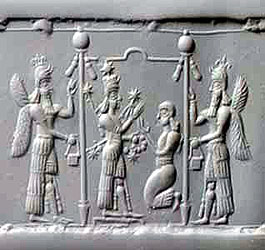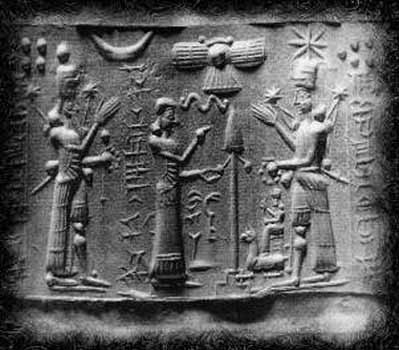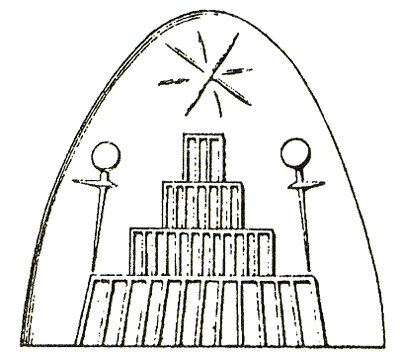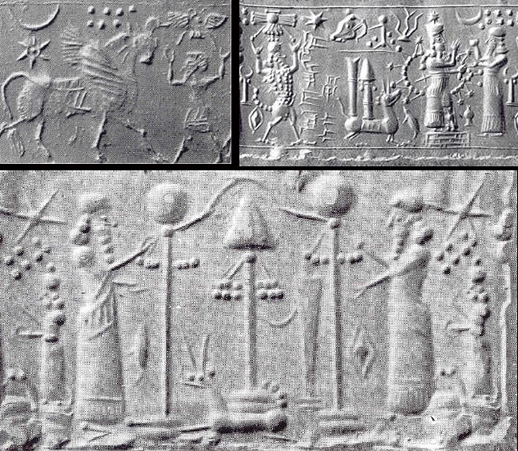It looks like you're using an Ad Blocker.
Please white-list or disable AboveTopSecret.com in your ad-blocking tool.
Thank you.
Some features of ATS will be disabled while you continue to use an ad-blocker.
share:

Ancient Sumerian clay tablet showing strange looking device with spheres suspended by wires connected to rods with pointed tips. Looks like some kind of technology?
www.mos.org...
Almost looks like this. If I did that right, it's a pair of Van de Graaff generators.
Almost looks like this. If I did that right, it's a pair of Van de Graaff generators.
reply to post by LUXUS
Why can't people enjoy limbo without people thinking it's something nefarious!?
Why can't people enjoy limbo without people thinking it's something nefarious!?
reply to post by LUXUS
It reminds me of the Solomon Columns.
The second picture, to me, even resembles the Sumerian one. The guy kneeling or sitting in the center and the other figure with his hands like he's praying or blessing him. The painting is called "Raphael, The Healing of the Lame Man"
It reminds me of the Solomon Columns.
The second picture, to me, even resembles the Sumerian one. The guy kneeling or sitting in the center and the other figure with his hands like he's praying or blessing him. The painting is called "Raphael, The Healing of the Lame Man"
edit on 15-7-2012 by TheLieWeLive because: (no reason
given)
Originally posted by LUXUS
Ancient Sumerian clay tablet showing strange looking device with spheres suspended by wires connected to rods with pointed tips. Looks like some kind of technology?
Tent canopy, oh and its' probably from a cylinder seal not a clay tablet. Where did you get the image from, know where it is from will tell you something about it.
reply to post by Hanslune

Here is a similar device, conical device with two spheres coming out of the base at angles. I dont think the tent canopy explains this.
Actually also looks like an electrical spark is jumping off the top !

Here is a similar device, conical device with two spheres coming out of the base at angles. I dont think the tent canopy explains this.
Actually also looks like an electrical spark is jumping off the top !
edit on 15-7-2012 by LUXUS because: (no reason given)
reply to post by LUXUS
I sent the orginal image off to a Sumerian expert we'll see what she says.
In the mean time you can look at what meanings the Sumerian accorded to 'standards'
Sumerian standards
I sent the orginal image off to a Sumerian expert we'll see what she says.
In the mean time you can look at what meanings the Sumerian accorded to 'standards'
Sumerian standards
edit on 15/7/12 by Hanslune because: (no reason given)
Originally posted by LUXUS
reply to post by Hanslune
Here is a similar device, conical device with two spheres coming out of the base at angles. I dont think the tent canopy explains this.
Actually also looks like an electrical spark is jumping off the top !edit on 15-7-2012 by LUXUS because: (no reason given)
They surely look like they have electrical properties. People seem to think that electricity was invented recently but in reality its been around since the big bang. The ancients surely harnessed some form of electricity whether it was static, magnetic, or just plain ole lighting. I am sure this would of made it in to their works.
Yes, don't forget the Bagdad Battery, they've been using electricity in one form or another for thousands of years
It is actually an impression taken from a cylinder.
www.metmuseum.org...
Seals of the early first millennium B.C. in Babylonia and Assyria were carved in the linear, drilled, cut, and modeled styles. The modeled style illustrated here derives from earlier Middle Assyrian seal carving and from the modeled sculpture in the palace of Sargon II (r. 721–705 B.C.), king of Assyria at Khorsabad. This style was used predominantly on seals showing scenes of contest and worship. On this cylinder seal, a statue of the goddess Ishtar stands on a platform within a canopied enclosure. Ishtar is identified by crossed quivers, a starred crown, and stars encircling her body. Two winged genies protect the enclosure, while a kneeling figure worships.
www.metmuseum.org...
edit on 15-7-2012 by kdog1982 because: (no reason given)
It looks to me like the figure is juggling.
s485.photobucket.com...
Could it simply be a festival or entertainment?
s485.photobucket.com...
Could it simply be a festival or entertainment?
reply to post by Hanslune
Here is the information on that cylinder seal I received by email. So not Sumerian at all but Assyrian
We thank Marduk for his rapid answer!
Here is the information on that cylinder seal I received by email. So not Sumerian at all but Assyrian
fairly standard, its a Neo Assyrian (934BCE-609BCE), representation of the king of heaven, in this case it shows the two gods Tammuz and Gishzida either side who guard the gateway to Heaven. You can tell that straightaway because they both have wings, the Assyrians put wings on all their creatures of heaven, to show how they were able to travel there and Tammuz and Gishzida are always depicted as twins. The God Ashur, figure on left (king of heaven) who is surrounded by five stars representing the five known classical planets:-
Mercury, Venus, Mars, Jupiter, and Saturn the two poles are Assyrian style standards, they are very distinctive, here is a better picture
...normally there is an image in the circular part, but this cylinder seal being only a couple of inches wide, it was just not possible for their artisans to fit an image in there. That is why the pole terminates in a point, because in real life that part was stuck into the ground. The human figure shown kneeling is a head priest (because he is bald), who is shown praising the king of heaven, the line with the semi circle is the roof of heaven. The entire flimsiness of the structure is supposed to remind the viewer of tents, which is a house that is capable of movement, which is how they imagined the heavens, never static, as above, so below
cylinder seals always represent well known aspects of mythology that were so popular to certain individuals that they used an image of them to sign/stamp their business contracts. They weren't the place to see experimental technology, because the image had to be known by the artisan who was commissioned to make it.
We thank Marduk for his rapid answer!
edit on 15/7/12 by Hanslune because: Edited to fix the link to the image
reply to post by Hanslune
Maybe someone should update the Metropolitan Museum of Art description of it,eh?
www.metmuseum.org...
Maybe someone should update the Metropolitan Museum of Art description of it,eh?
www.metmuseum.org...
Originally posted by kdog1982
reply to post by Hanslune
Maybe someone should update the Metropolitan Museum of Art description of it,eh?
www.metmuseum.org...
Good find Kdog1982
Well lol, let see what he has to say then the two descriptions differ over who the central figure is, is it Ishtar or the king of heaven?; let stand back and watch a the experts debate it (rather common in intrepretation of the meaning of ancient religion).


Above Sumerian ziggurat with large poles either side terminating in spheres or rings.
Other image below that shows one of these conical devices with spheres either side.
reply to post by LUXUS
How do you know they are Sumerian and not Assyrian? Unless you can read the language it is difficult for non-expert to tell.
I presume you are rejecting the explanation of standards then?
How do you know they are Sumerian and not Assyrian? Unless you can read the language it is difficult for non-expert to tell.
I presume you are rejecting the explanation of standards then?
reply to post by Hanslune
I don't know if its Sumerian or Assyrian, I have noticed that Sumerian art is usually a little cruder then Assyrian art so that's my only reason for thinking so. Also they used many of the same symbols and had the same Gods so for me its not that important.
I am willing to accept that it is a devotee kneeling an the feet of a statue because I can now see the statue is on a raised platform. I'm interested to know how the expert would explain the spark jumping from the conical device and the poles which are depicted the same height as the Ziggurat with spheres on top.
I don't know if its Sumerian or Assyrian, I have noticed that Sumerian art is usually a little cruder then Assyrian art so that's my only reason for thinking so. Also they used many of the same symbols and had the same Gods so for me its not that important.
I am willing to accept that it is a devotee kneeling an the feet of a statue because I can now see the statue is on a raised platform. I'm interested to know how the expert would explain the spark jumping from the conical device and the poles which are depicted the same height as the Ziggurat with spheres on top.
Originally posted by Hanslune
Well lol, let see what he has to say then the two descriptions differ over who the central figure is, is it Ishtar or the king of heaven?; let stand back and watch a the experts debate it (rather common in intrepretation of the meaning of ancient religion).
Marduk responds (Marduk posts on another forum)
Well thats cool, ishtar is the queen of heaven, so they are both shown with five stars, I didn't spot the quivers and the figure doesnt look very female to me. She's wearing male dress, put that down to the artist I guess.
They are certainly not Djinn, they are a common era creature, the remains of what happened to the rest of the Gods when arabs became monotheistic, the bad gods became Djinn, the good gods became angels, the gods associated with the gates of heaven are always Tammuz (Dumuzid) and Ninghizzida, they are mentioned in the story of Adapa
Saying: " Adapa, before the face of Anu the King thou art to go
... to heaven
When thou comest up, and when thou approachest the door of Anu,
At the door of Anu, Tammuz and Gishzida are standing,
"they will see thee, they will ask thee; 'Sir,'
For whose sake dost thou so appear, Adapa? For whom
Art thou clad in a mourning garment?' 'In our country two gods have vanished, therefore
Am I so.' 'Who are the two gods, who in the land
Have vanished?' 'Tammuz and Gishzida.' They will look at one another and
Be astonished.
So Marduk states he mis-identified the Queen of Heaven instead of as the King of Heaven but questions the identification of the two gods Tammuz and Gishzida as 'genies'.
However the two experts do agree on one thing the Assyrian cylinder seal shows a scene from the Assyrian religion and that the 'standards' are
stands on a platform within a canopied enclosure
the two poles are Assyrian style standards
Of course if you want to believe they are something else, then please do so....
reply to post by LUXUS
Hey Luxus I'm send you a PM where you can contact him yourself, let us know what he says please
Hey Luxus I'm send you a PM where you can contact him yourself, let us know what he says please
new topics
-
Let's talk planes.
General Chit Chat: 4 hours ago -
January 6th report shows disturbing trend (nobody is shocked)
US Political Madness: 5 hours ago -
Inexplicable military simulation - virtual reality showdown in the night..
The Gray Area: 6 hours ago -
The Truth about Migrant Crime in Britain.
Social Issues and Civil Unrest: 7 hours ago -
Trudeau Resigns! Breaking
Mainstream News: 9 hours ago -
Live updates: Congress meets to certify Trump's presidential election victory
US Political Madness: 10 hours ago -
Gravitic Propulsion--What IF the US and China Really Have it?
General Conspiracies: 10 hours ago -
Greatest thing you ever got, or bought?
General Chit Chat: 10 hours ago
top topics
-
Trudeau Resigns! Breaking
Mainstream News: 9 hours ago, 24 flags -
January 6th report shows disturbing trend (nobody is shocked)
US Political Madness: 5 hours ago, 18 flags -
Live updates: Congress meets to certify Trump's presidential election victory
US Political Madness: 10 hours ago, 12 flags -
The Truth about Migrant Crime in Britain.
Social Issues and Civil Unrest: 7 hours ago, 10 flags -
Gravitic Propulsion--What IF the US and China Really Have it?
General Conspiracies: 10 hours ago, 9 flags -
Greatest thing you ever got, or bought?
General Chit Chat: 10 hours ago, 3 flags -
Let's talk planes.
General Chit Chat: 4 hours ago, 3 flags -
Inexplicable military simulation - virtual reality showdown in the night..
The Gray Area: 6 hours ago, 2 flags
active topics
-
Trudeau Resigns! Breaking
Mainstream News • 63 • : NoCorruptionAllowed -
Musk calls on King Charles III to dissolve Parliament over Oldham sex grooming gangs
Mainstream News • 197 • : Freeborn -
January 6th report shows disturbing trend (nobody is shocked)
US Political Madness • 29 • : fringeofthefringe -
Candidate TRUMP Now Has Crazy Judge JUAN MERCHAN After Him - The Stormy Daniels Hush-Money Case.
Political Conspiracies • 2181 • : WeMustCare -
Joe Biden gives the USA's Highest Civilian Honor Award to Hillary Clinton and George Soros.
US Political Madness • 58 • : WeMustCare -
Judge rules president-elect Donald Trump must be sentenced in 'hush money' trial
US Political Madness • 29 • : Xtrozero -
Volcano Watch 2025
Fragile Earth • 8 • : Coelacanth55 -
Let's talk planes.
General Chit Chat • 6 • : Boomer1947 -
OK this is sad but very strange stuff
Paranormal Studies • 7 • : Solvedit -
Sorry to disappoint you but...
US Political Madness • 30 • : fringeofthefringe
